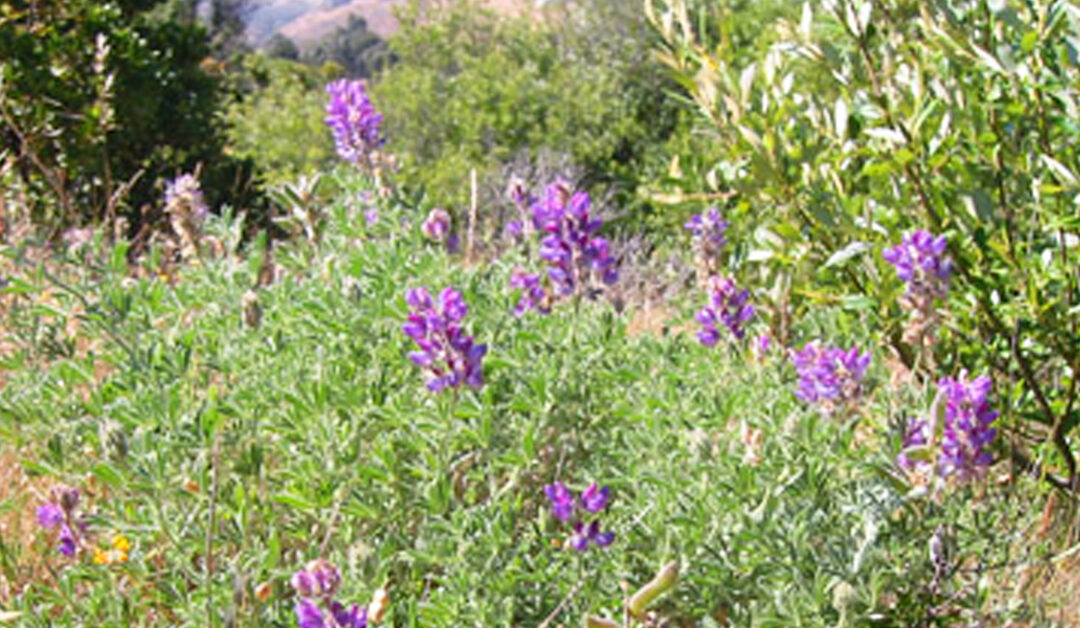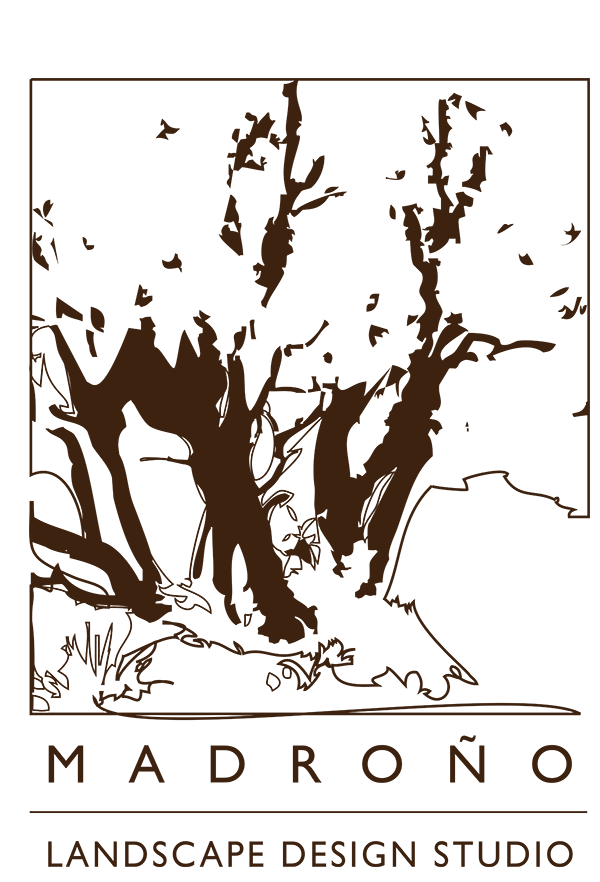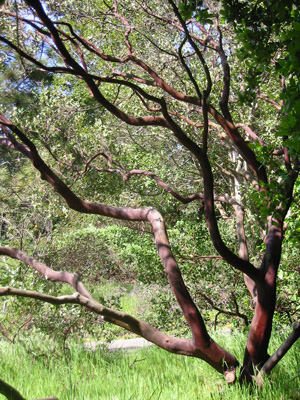
Standing solemnly in the middle of the hectic San Francisco peninsula, San Bruno Mountain nurses a pocket of pre-Colombian life largely unchanged by modern times, a rural island in an urban sea. Harvard biologist Edward O. Wilson ranks this site among the world’s greatest “biodiversity hot spots” alongside Madagascar, Borneo, and the forests of Tanzania. These 3,000-plus acres of open space support more than 250 species of native plants, approximately 40 varieties of butterfly (including four rare and endangered species), and multiple robust interdependent communities of mammals, reptiles, amphibians, and birds. Such fertile associations give voice to an ancient and fundamental story, an epic neither silenced by the drone of traffic on nearby freeways 101 and 280 nor intimidated by the bustle of moat-like burgs Daly City, Colma, Brisbane, and South San Francisco “The Industrial City” self-proclaimed in large white letters on SBM’s southern flank.
Much of the mountain is dry grassland, sun-scorched, appearing misleadingly drab to passing carloads of commuters. A closer exploration by foot reveals a hidden world of texture and color, subtleties and complexities. The onset of November rain awakens the landscape with a whisper of green, a slow murmur that builds through the winter to a lusty huzzah of early spring wildflowers. Enthusiasts hail SBM as the earliest bloomer in the Bay Area, and the most important native plant site in San Francisco. Even now, delicate fragrant blue-green shoots of California sagebrush (Artemisia californica) have appeared beneath the deadheads of last season, and plucky lizard tail (Eriophyllum staechadifolium) is resprouting everywhere.
But a wild west wind howls across these sandstone peaks, killing any plant that dares to grow too tall. This gives the evolutionary edge to those species best able to hunker down and hug the slope: many ordinarily-large shrubs grow flat like carpets, while oaks such as Quercus chrysolepis and Q. wislizenii — which can reach 40-70 feet when growing inland — go bonsai here at seven to eight feet.
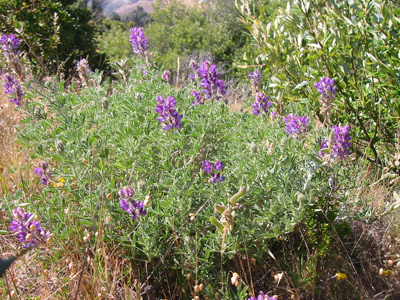
A favorite with butterflies, our local coyote mint (Monardella villosa var. franciscana) survives the wind by growing here in association with the dominant coyote brush, tucking its lower stems under the spreading branches of the larger shrub and thereby supporting its slender flower stalks peeking out just above. Other nectar and larval food plants of the endangered Mission Blue and Callippe Silverspot butterflies include brodiaea (B. pulchella), coast wild buckwheat (Eriogonum latifolium), horkelia (H. californica), johnny jump-up (Viola pendunculata), and three species of lupine (Lupinus albifrons, L. formosus, and L. variicolor).
Manzanitas bloom in December, with their clusters of delicate urn-shaped blossoms draped among trembling, upright leaves, and this mountain claims three noteworthy specimens. The Eastwood manzanita (Arctostaphylos glandulosa) grows four to eight feet tall, with a gnarled trunk of deep red wood and an exquisite white flower. The bearberry (A. uva-ursi) grows prostrate, with trailing branches that form roots at the nodes, forming an attractive ground-cover. But SBM’s proudest manzanita is Arctostaphylos imbricata, a rare and endangered species found nowhere else on earth, whose many-branched, creeping habit and bristled, clasping leaves are prized by discerning horticulturalists. Difficult to find in the trade, A. imbricata is carried by the U.C. Berkeley Botanical Garden and the Strybing Arboretum nursery.
Also endemic to the Bay Area, the rare coast rock cress (Arabis blepharophylla) clings to rocky outcroppings and grassy slopes of SBM, with a basal rosette of furry leaves and a showy purple flower from mid-winter through May.
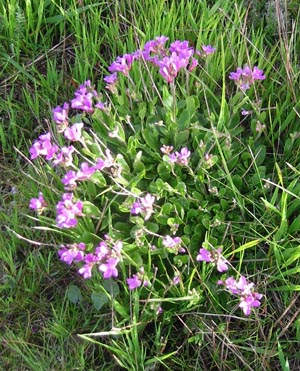
Six known middens or shell mounds on the lower slopes of SBM attest to the Ohlone Indians who lived here for at least five thousand years. These middens, the deep-piled offscourings of ancient villages, reveal themselves after heavy rains when fast-responding vegetation turns these organically rich sites an emerald green literally overnight. The Ohlone located their middens based on proximity to fresh water, shelter from the wind, ease of access to the shore, and the presence of the California buckeye (Aesculus californica), a tree they revered despite the toxicity of its fruit to humans. Tall, deciduous buckeyes cut handsome figures in the winter, with their thick denuded branches silhouetted in the mist like slow, graceful calendars marking time until the leafy return of spring.
Gusts of wind moan in the gullies and canyons of SBM, carrying voices from the past. Can you hear them? Listen for snippets of Spanish, the tongue of missionaries and rancheros whose early assessments of the land concerned only its suitability for grazing cattle. Eavesdrop on the words of James Roof, the Daly City-born native plant champion whose spellbinding oration to the San Mateo County board of supervisors helped spare the mountain from annihilation in the 1970s. Heed the furtive whispers of Besh and Thelma, the homeless couple who built their dwelling here in an Owl Canyon oak tree, practicing good stewardship by removing invasive weeds and trash from the canyon and helping to repair trails, yet were uprooted last year by police and county officials under a blaze of public outcry and media coverage. Remember the bombast of industrialists with their inscrutable plans, like the 1965 proposal to blast 200 million cubic yards of rock and earth from the summit ridge and use the rubble as bay-fill to expand the airport. Hark the reason of David Schooley, author and educator, poet and polemic, infamous eschewer of shoes and motorized vehicles, the driving force and creative voice of San Bruno Mountain Watch. And listen closely for the faint pulse of the ancient Ohlone stories, like the myth of the bear who brought medicine to the people by showing us the curative properties of a prized local plant: in the native language, chaw-ree-sheem; in Spanish, yerba buena; in botanical Latin, Satureja douglasii.
* * *
Geoffrey Coffey was invited to spend Thanksgiving with the Asteraceae family. He is the founder of Madroño landscape design studio, a princpal of Bay Natives nursery, and a freelance writer for the San Francisco Chronicle.

Madroño president Geoffrey Coffey started the company in 2005 out of the back of a pickup truck. His garden column, “Locals Only”, first appeared in the San Francisco Chronicle in 2002. He lives in San Francisco with his wife and two children, where he also sings and thumps the bass for Rare Device.

